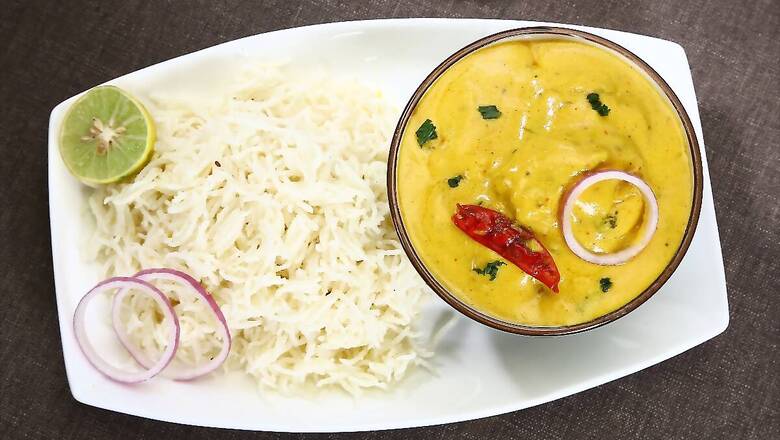
views
Now for years I’ve wandered the small bylanes in the old parts of Mumbai and the iconic B. Bhagat Tarachand restaurant has always been my go to for a solidly good Dal Fry. B. Bhagat Tarachand is just beyond Zaveri Bazaar in the Kalbadevi area of Mumbai, an area which is home to several Kutchi and Gujarati traders, shopkeepers, jewellers and businessmen, and generates a colossal demand for good quality vegetarian food. Hence, the area boasts of several exceptional vegetarian thali restaurants, mostly Gujarati and Kutchi, and carts full of innovative fusion street food. But B. Bhagat Tarachand is different because it serves Punjabi, Gujarati food, but mainly Sindhi food, and all their food has the influence of Sindhi cooking. For example, the Dal Fry has a potent tadka of fried onions and jeera, and in abundance. The Paneer Bhurji is not crumbly and dry, but rich and creamy and blended with flavours of tomato, chilly and turmeric. And the quintessential Sindhi papad is served fried, roasted or crushed and spiced and called Papad Churi. Crunchy and spicy that can be mixed with everything on your plate.
What Sets Sindhi Cuisine Apart
But while B. Bhagat Tarachand in their 125-year-old history have adapted their Sindhi cooking to Punjabi and Gujarati tastes, it will be interesting to explore the Sindhi story and their food. The Sindhis are as old as civilization itself. In fact, they originated from the cradle of civilization—Sindh and the Indus Valley. Originally a nomadic trading tribe, the Sindhis have faced persecution through time, especially during the Partition of India that did unparallel damage to their life, land, possessions and identity. They lost everything and fled to India, settling down in refugee colonies mainly in the north-western part of the country. Resilient and with a keen instinct to survive, they adapted, toiled, prospered and are a wealthy and successful entrepreneurial community today.
Like Sindhis, their cuisine also reflects adaptability. While, Sindhi food can trace culinary influences back to the Rajputs, the Mughals, the Sikhs, the Arabs and the Turks and the Soomras, (indigenous Sindhis, of Rajput origin who converted to Islam), to put it simply, Sindhi cooking is distinctive in three ways. Slow cooking, layering of garam masala and the art of combining sweet and savoury flavours.
Notoriously renowned for eating papad with everything, Sindhi food is quite distinctive and grand and is customarily non-vegetarian, though it includes tonnes of vegetarian dishes, snacks and savouries as well. Like the Punjabis, the Sindhis too use a lot of onion and tomato, which form the base of nearly all Sindhi dishes. Amchoor (dry mango powder) and basar (onions that have been sautéed white instead of brown) also play a big role. But with such a rich and distinctive food culture, there are hardly any Sindhi restaurants in either Mumbai or Delhi that serve their vast non-vegetarian repertoire of mutton dishes, be it kheema or the offal.
Where to Get the Best Sindhi Food
On that note, let me start with breakfast. Chembur Camp in the mornings is just filled with the flavours of frying Pakwan served with Dal. Dal Pakwan at Vig Refreshment, Chembur (East), is the ultimate Sindhi breakfast indulgence. It is a dish-sized, deep-fried poori flavoured with jeera and ajwain. This crisp flaky poori is served with a dal of whole chickpea cooked in ghee with jeera, red chilli powder, amchoor and garam masala and served with green chutney (fresh coriander leaves, green chillies and lemon juice) and a sweet chutney (tamarind, dates, jaggery and roasted cumin), garnished with chopped raw onions.
Although some say the best Sindhi breakfast is Koki. Koki is a wheat flour paratha that is thick and full of ghee. Finely chopped onions, green chillies, garlic and coriander are added to the flour and it is kneaded stiff. It is rolled out thick and finished on a tawa with lots of oil or ghee. You can eat Koki with anything, curd, pickle, papad, or even Sindhi mutton as I do.
Kailash Parbat in Colaba and Guru Kripa in Sion are Mumbai’s most iconic Sindhi restaurants. The Mulchandani brothers started Kailash Parbat in the 1950s. With humble beginning as roadside halwais in Karachi, Partition brought them to Bombay. Their chaats and sweets were famous in Pakistan and they recreated the same magic in Colaba. It’s one of the few places where you can actually get Aloo or Arbi Tuk, and Beeh Masala or lotus stem cooked Sindhi style. But if you want a good Sindhi Kadhi, it’s got to be Guru Kripa. Here they serve a classic Sindhi Kadi with rice. Sindhi Kadhi Chawal is a vegetarian curry made with potatoes, tamarind, curry leaves and green chillies, and thickened with besan. It’s sour and spicy and at Guru Kripa, it is traditionally served with pattice, sweet boondi and papad, once again reinforcing the Sindhi’s fondness for mixing sweet with savoury and spicy.
If you have an iron stomach, then there is a street stall at Chembur Camp, simply called Gopal’s Mutton and Chicken. Although there is a lot of tandoori and kebabs here, don’t mistake it for a Punjabi joint. It’s all done Sindhi style and the secret is the marinades. The Chicken Potta to Gurda Kapura Mix, it just flies off the grill every evening. The biryani is served with flaming hot gravy as is the most popular “sandwich”, which is a cutlet between bread pav, served with spicy onion gravy.
But in Khar, Mumbai, right around Tharu Sweets Mukhi Bhandar is Sindhful. Tharu is a Sindhi sweetmeat shop that specialises in sweets like Sev-Barfi, which is as Sindhi as it can get. Savoury ‘Sev’ is mixed with sweet mawa to make an unusual but spectacular mithai. They also do chaat like Ragda Pattice and samosa. But Sindhful is the modern Sindhi restaurant. They brag that their recipes are age-old and their spices are authentic, and I must say their food is quite good. Especially the Sindhi Mutton Masala, Green Seval Chicken Curry and their kheema patties.
In the end I have to say two things. First, I have some really good Sindhi friends and nothing tastes as good as a homemade Sindhi Kadhi, Sindhi Mutton and Sai Bhaji, Seel Bhaji (onion, ladies’ fingers, besan ki kachori), Dhoda Palli (soft bread served with spinach and tomato) along with papad and Dhaarun Ji Chutney (chutney made with green coriander, fresh green chillies and onion). And the second thing I want to say is, I started this column thinking I had eaten enough non-vegetarian food for this season, but I guess man cannot fight his innate nature and neither can I.
Read all the Latest News, Breaking News and Coronavirus News here. Follow us on Facebook, Twitter and Telegram.


















Comments
0 comment